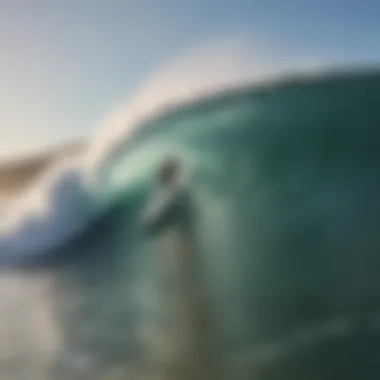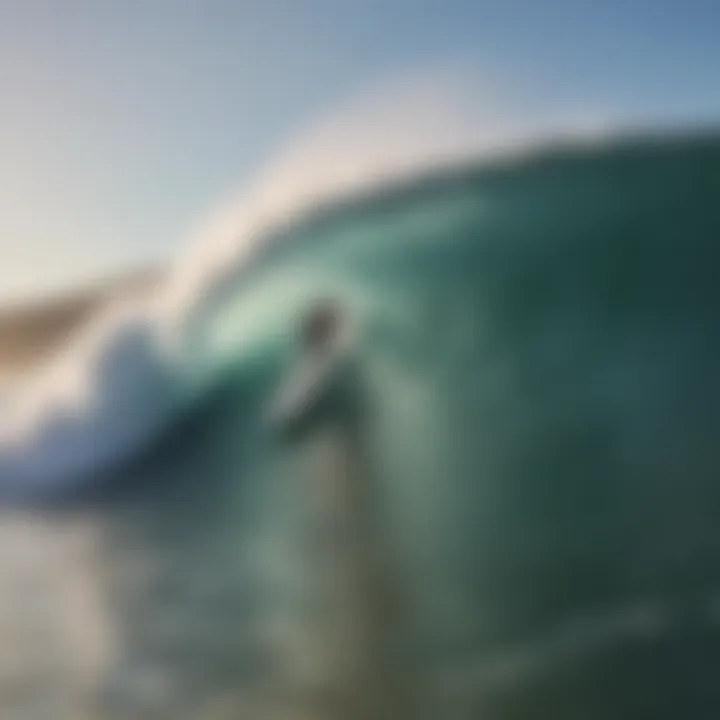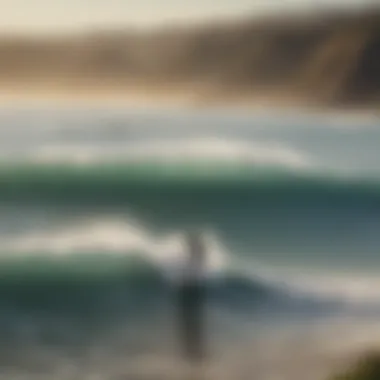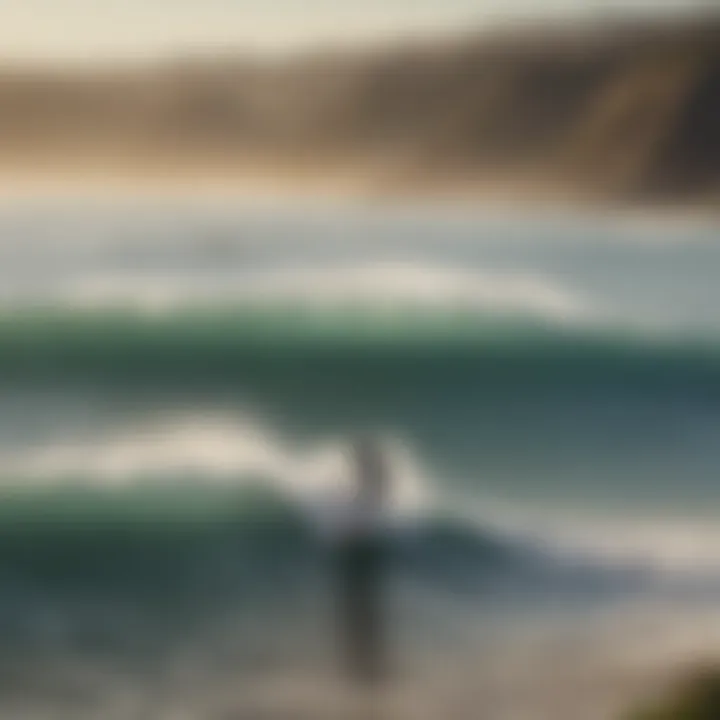Surfline Pismo: Your Guide to Surfing in Pismo Beach


Intro
Surfing is more than just a sport; it's a way of life that intertwines with the community, environment, and the rhythm of the waves. Pismo Beach in California stands as an iconic surfing destination, drawing both novices and experienced surfers alike. As the sun rises and casts its golden shimmer over the ocean, myriad surfboards dot the horizon, each rider chasing the perfect wave. This guide aims to enrich your surfing experience in this vibrant coastal haven.
By delving into the depths of Surfline Pismo, surfers will find a wealth of information ranging from essential surfing techniques to gear recommendations and local spots that cater to all skill levels. To fully embrace the spirit of surfing in Pismo, it's crucial to not only understand the mechanics of the sport but also to appreciate the culture that surrounds it. It's about riding waves, engaging in sustainable practices, and coming together as a community under the expansive Californian sky.
Let’s embark on this journey together, exploring what makes Surfline Pismo an invaluable resource for surf enthusiasts.
Surfboarding Techniques
Surfing techniques can be the differentiating factor between catching a wave and missing out altogether. This section unfolds tips and methods for surfers at every level, emphasizing foundational skills while also exploring nuances for those who are looking to elevate their game.
Beginner Tips for Mastering the Basics
For those just getting their feet wet, the initial steps can feel daunting. Here are a few tips that could smooth the ride:
- Choose the right surfboard: Longer boards often provide more stability. A soft-top board may also be easier for beginners.
- Learn to paddle efficiently: A good paddling technique ensures you have enough momentum to catch waves. Keep your body streamlined and your strokes even.
- Pop-up practice: Transitioning from lying on your board to standing is crucial. Start on dry land if you have to, practicing that swift maneuver.
- Understand the waves: Not every wave is rideable. Observing the behavior of waves helps you pick the right moment to paddle.
Advanced Techniques for Seasoned Surfers
For those seasoned in the art of surfing, refining your skills can lead to a more rewarding experience. Consider diving into:
- Carving turns: Engage your core as you shift your weight to cut through waves fluidly. The more you practice, the more intuitive this becomes.
- Aerial maneuvers: Big jumps can wow the crowds. Start with small boosts and work your way up to more complex tricks.
- Understanding the lineup: Knowing where to position yourself in relation to other surfers and waves can significantly increase your chances of catching prime swells.
"Surfing is a way of life. The ocean becomes a part of your being, shaping not just your skills but your perspective on the world around you."
Surfboard Equipment
Having the right equipment can make all the difference in your surfing experience. Let’s explore what you should consider bringing along as you hit the water.
Reviews of the Latest Surfboards on the Market
With technology advancing, surfboards continually evolve. A few noteworthy boards currently making waves include:
- Channel Islands Waterhog: A versatile board for various conditions, offering stability and great maneuverability.
- Firewire Dominator: Known for its lightweight design, it’s suitable for both beginners and advanced riders looking for speed.
- Lost RNF Retro: A nod to the past with a modern twist; great for catching those playful summer swells.
Essential Gear for Every Surfboarder
When preparing for a day out in the waves, ensure you have the following:
- Leash: This keeps your board attached to you, preventing it from drifting away after a wipeout.
- Wetsuit: Depending on the season, a properly fitting wetsuit will keep you warm and flexible in cold waters.
- Wax: A vital element for maintaining grip on your surfboard, ensuring you don’t slip off unexpectedly.
Arming yourself with the right information and equipment is key to enhancing your surfing competencies while you enjoy the thrill of Pismo Beach. The harmony of simplicity and complexity in surfing mirrors the waves themselves—every ride is unique, just like every surfer.
Understanding Surfline Pismo
Surfline Pismo isn't just a name tossed around by the surf crowd; it's a vital cornerstone for anyone looking to immerse themselves in the world of surfing at Pismo Beach. Understanding this platform gives surfers access not only to real-time conditions but also a whole community that thrives on sharing tips, experiences, and love for the ocean. With technology reshaping how enthusiasts interact with the sport, Surfline Pismo emerges as a modern-day necessity.
Definition and Purpose
At its core, Surfline Pismo serves as a comprehensive resource for surf enthusiasts ranging from beginners to seasoned veterans. This online platform offers detailed surf reports, forecasts, and even live streaming of certain surf spots. By providing accurate data on wave heights, swell directions, and wind conditions, it helps surfers make informed decisions about when to hit the waves. The goal is simple: to enhance the surfing experience and promote safety while enjoying this exhilarating sport.
But what truly sets Surfline Pismo apart is its community-driven approach. Surfers can find like-minded individuals, join discussions, and engage in various local events. Whether one is planning a casual afternoon surf or participating in a competitive event, this platform acts as a reliable navigator in the ever-changing ocean.
Historical Context
Historically, surfing at Pismo Beach has deep roots as far back as the mid-20th century, when the waves first captured the attention of locals and travelers alike. Over the decades, the area has transformed into a surfing haven, boasting steady breaks that suit various levels of expertise. Surfline Pismo arose in response to the evolving needs of surfers in this region. Initially, surf reports were meager and often inaccurate, leading to countless missed opportunities. As technology advanced, platforms like Surfline began to offer more precise and timely information. This shift contributed to a more connected community of surfers who could share experiences and anticipate conditions more reliably.
The Role of Technology in Surfing
In today's world, technology is more than just a convenience; it signifies evolution in the surfing culture. Devices like smartphones have revolutionized how surfers access real-time information and interact with each other. Surfline Pismo stands at the forefront of this shift, offering tools such as mobile apps that allow surfers to check the latest conditions on the go.
Moreover, with advancements in weather prediction algorithms, surfers receive more accurate forecasts than ever before. Beyond just wave heights, these technologies provide insights into variables such as tidal movements and atmospheric conditions—all crucial for planning the perfect surf session.
As we continue to embrace what technology offers, Surfline Pismo becomes an indispensable ally for those serious about their surfing pursuits. It embodies the spirit of camaraderie, harnessing data to unite a passionate community around the love for the ocean.
Surf Conditions: A Detailed Analysis
Surf conditions can prove to be the heart and soul of any surfer's experience, particularly at a spot like Pismo Beach. As waves crash and tides ebb and flow, understanding these elements can set the scene for memorable days on the water. From beginners to seasoned surfers, everyone can benefit by diving deep into the intricacies of surf conditions. An informed surfer isn’t just about slapping on some sunscreen and grabbing a board; it’s about truly knowing the elements at play in the ocean.
Understanding Waves and Tides
Waves are the lifeblood of surfing. They transform the ocean into a surge of potential, beckoning surfers to ride them with skill and finesse. Tides, which create variations in wave size and power, are equally important. A combination of tidal movements and wave formations can dictate surf conditions significantly. In Pismo, catching a good wave doesn’t solely depend on luck; it’s understanding when and where to catch them.
Factors Influencing Surf Conditions
Numerous factors affect the surf conditions, but three major elements stand out: wind patterns, current influences, and tide cycles.
Wind Patterns


Wind patterns play a crucial role in shaping wave quality. Wind creates waves, but the direction and strength of that wind can make all the difference. On days when offshore winds sweep in, surfers often benefit from a smoother wave face. This sets the stage for spectacular rides.
However, consistent onshore winds can lead to choppy conditions, much less favorable for surfing. Surfers in Pismo need to keep a close eye on the forecast, as a gentle breeze can suddenly stir up waves into a frenzy or flatten them altogether. The key characteristic for local surfers to note is the wind direction; it’s something you cannot afford to neglect when planning a surf session.
Current Influences
Currents also exert a significant influence on surf conditions. These can either be your friend or foe. Current influences can shape wave breaks, affecting how waves disperse as they approach the shore. Generally, Pismo handles current well, but certain days can produce stronger currents that can throw even an experienced surfer off balance.
One notable aspect of currents is the rip tide, which can sneak up on folks if they aren’t careful. Understanding where rip tides form is essential for safety as well as for positioning yourself in the optimal spot to catch waves. Currents also interact with wind patterns, creating a complex dance that impacts your surfing experience.
Tide Cycles
The impact of tide cycles can't be stressed enough in the world of surfing. Just as the waves fluctuate with the surf, the shifts in tide can dramatically change wave size and break quality. A rising tide will often create mellower, more forgiving waves, making it an ideal time for less experienced surfers to hit the water. Conversely, a falling tide can yield steeper, faster edges that challenge even the seasoned rider.
Being conscious of when to surf relative to tide schedules can be your secret weapon. Engaging with local tide charts can really help pinpoint the moments when the ocean will be at its most cooperative.
Seasonal Variations
As seasons shift, so do surf conditions. Each season delivers its own unique set of circumstances—some waves might be powerful in winter and glassy in summer. Therefore, it’s essential for surfers to adapt their approach as the seasons change.
This understanding of seasonal variations helps prepare surfers for the adventures ahead. Pismo Beach is no exception, as each time of the year can introduce different wave patterns and seasonal winds that you’d be wise to consider.
Overall, being aware of the surf conditions is not just a casual addition to your surf routine; it's a fundamental part of successfully navigating the ocean. Understanding waves, winds, currents, and tides equips surfers with the knowledge they need for the ultimate surfing experience in Pismo Beach.
Equipment Essentials for Pismo Surfers
When it comes to surfing at Pismo Beach, having the right gear is as critical as the waves themselves. The right equipment not only enhances performance but also ensures safety and comfort. Whether you are dabbling in the waves or carving your way through them like a pro, understanding your gear can be a game changer. From surfboards to wetsuits, each piece of equipment plays its part in the complete surfing experience.
Types of Surfboards
Shortboards
Shortboards are typically suited for advanced surfers looking to perform quick turns and agile maneuvers. These boards often measure between 5’6" to 6’6" and are relatively narrow. This design allows for increased speed and responsiveness. Their lighter weight also contributes to higher acceleration. However, if you're a beginner, shortboards can be tricky to handle due to their low stability.
One might say riding a shortboard is akin to dancing on water — it requires skill and a certain finesse. The challenge is a double-edged sword; while they enable some serious tricks, many find their learning curve steep.
Longboards
In contrast, longboards typically range from 8’ to 12’, making them a favorite among beginners and experienced surfers alike. Their increased length offers better stability, making it easier to catch waves and ride them smoothly. Many consider longboards to be the "classic" surfboard, with a nostalgic connection to the sport's roots.
One distinctive feature of longboards is the nose, which often comes rounded. The unique design allows for a variety of styles, from laid-back rides to nose riding. While they are not as fast as shortboards, their stable ride makes them enjoyable for leisurely days on the ocean.
Fish Boards
Fish boards, as the name suggests, have a unique fish-like shape, often featuring a wider tail and shorter length. With the versatility to navigate smaller waves, they are ideal for those days when the surf is less than spectacular. These boards are known to provide a fun experience without the intensity that sometimes accompanies shortboarding.
A noticeable characteristic of fish boards is their swallow tail, which helps in generating speed even in weaker waves. They cater to surfers who want a playful ride with plenty of maneuverability. Despite their advantages, they may lack the performance capabilities that dedicated shortboarders might seek.
Wetsuits: What to Consider
Selecting a wetsuit involves considering factors like thickness, material, and fit. The cold waters of Pismo Beach call for wetsuits that provide insulation while allowing flexibility. A thinner suit might suffice during summer months, while winter sessions might require something thicker to keep the chill at bay. Additionally, wetsuits come in various styles including full-suits, spring suits, or even rash guards, each suited to different conditions and personal preferences.
Accessories for Enhanced Performance
Leashes
A leash is often an overlooked but crucial accessory. It keeps your board close, especially after a wipeout. Without it, losing your board can result in hazards for you and others. Most commonly, surfers choose leashes that match the length of their boards for optimal performance.
Fins
Fins play an important role in control and tracking across the waves. Depending on your board and technique, you may want to experiment with different fin configurations and sizes. A well-matched fin setup can enhance your grip on turns, making for smoother rides.
Surf Wax
Finally, surf wax is key for maintaining grip on your board. Different types of wax are available, padded towards various conditions. Applying the right wax for the water temperature ensures that you won’t wipeout unexpectedly while trying to catch that perfect wave.
"The essence of surfing lies not just in catching waves, but in understanding how the equipment works in sync with your skills and the ocean's rhythm."
In summary, equipping yourself with the right gear is essential for any surfer looking to thrive at Pismo Beach. It's all about finding the perfect balance that suits your skill level, experience, and the conditions of the surf. Keep in mind that the right board, suitable wetsuit, and handy accessories create a holistic surfing experience, promoting not only enjoyment but also safety in the water.
Local Surf Spots in Pismo Beach
When it comes to surfing, knowing where to ride the waves is paramount. Pismo Beach is rich in diverse surf spots that cater to different skill levels and styles. Each location offers a unique experience, making it essential for both seasoned surfers and novices to explore these local gems. The importance of this section lies in identification and understanding of various surf breaks. Not only does it highlight where to find ideal conditions, but it also sheds light on the community and culture surrounding each beach.
Overview of Popular Beaches
Pismo Beach boasts several shores that are famous among the surfing crowd. The larger waves at Pismo State Beach attract experienced surfers seeking to test their skills. Here, the swells can rise significantly, particularly during winter months. Each surfer has stories about the thrill of catching a wave as the sun sets behind them.
Then, there's Dinosaur Caves Park, which serves as a fantastic spot for beginners. This area tends to provide gentle waves, making it an ideal learning ground. Families often feel right at home here, since there’s enough sand space for kids to play while adults catch some waves.


A quick pitstop at Oceano Dunes reveals another dynamic environment. With its unique position, this beach often shapes conditions that cater less frequented sessions. Here, craft a blend of riding waves combined with a beach vibe that radiates adventure.
Surfing Etiquette in the Area
Engaging in the surfing community requires more than just paddling out. It’s crucial to respect local norms to foster goodwill and safety in the water. Here are some key points to keep in mind:
- Know Your Limits: If you’re a beginner, stick to areas that match your ability. It’s better to grow gradually than dive into intimidating waters.
- Respect the Locals: Pismo Beach has a strong local surf community. If you’re new, let experienced surfers take priority, especially when they’ve been waiting for a wave.
- Communicate: If you spot a wave you’re both interested in, make eye contact. The surfer closest to the peak typically has the right of way, so communicate clearly to avoid collisions.
- Clean Up: Carry your trash out. Keeping the beaches clean helps preserve the surf scene for future enthusiasts.
Hidden Gems: Off the Beaten Path Locations
Venturing beyond the popular spots can be rewarding. There are lesser-known locations that can offer solitude and untouched nature:
- Avila Beach: A short drive from Pismo, this beach often serves as a hidden sanctuary with fewer crowds. Its varied swell makes it perfect for all levels.
- Pirates Cove: Accessible via a steep trail, this secluded beach promises stunning views along with some fantastic waves. Not usually crowded, it’s a great place to unwind after surfing.
- North Pismo Beach: This area provides a mix of fun waves and marine wildlife observations. It’s ideal for those looking to experience nature and surfing simultaneously.
Surfing at these hidden locations allows you to escape the hustle and bustle of more frequented spots while still enjoying the essence of coastal California. The secrets of Pismo Beach run deep—every wave carries whispers of surfers who’ve come before and those who continue to ride today.
Connecting with the Surfing Community
The surfing community at Pismo Beach is more than just a group of individuals riding waves; it's a family tied together by shared experiences, passions, and local culture. This section highlights the importance of building relationships within this vibrant community, as it's crucial for both personal growth and understanding the dynamics of the sport.
Engaging with other surfers can enhance skills, provide safety, and foster a sense of belonging. By connecting with fellow surf enthusiasts, individuals can learn from the trials and triumphs of seasoned surfers and gain insights about the local surf culture – something that no manual can teach. The encouragement and camaraderie found in surf interactions often lead to lifelong friendships, making the waves feel even more rewarding.
Additionally, being part of the surfing community often translates into opportunities for collaboration and participation in local events. These gatherings not only serve as fun social outings but also drive awareness around sustainability and conservation efforts that are vital for the health of our oceans and beaches. In essence, the significance of this connection cannot be overstated, as it weaves into the fabric of what it means to be a surfer in Pismo Beach.
Local Surf Clubs and Organizations
In Pismo Beach, local surf clubs and organizations hold a central role in fostering community spirit and surf culture. Joining a club is a gateway for surfers of all skill levels to engage with each other, share knowledge, and partake in organized activities. These clubs often host regular meet-ups that include everything from skill workshops to beach clean-ups.
The camaraderie built in these settings is not merely about improving surfing skills but also gathering like-minded individuals committed to protecting the coastal environment. Members often partake in initiatives that emphasize sustainable practices, such as adopting eco-friendly gear and promoting responsible surfing behaviors.
Some notable clubs you may want to check out include the Central Coast Surf Club and the Pismo Beach Longboard Club. They provide great channels for networking, skill-sharing, and even occasional contests which can add a little spice to the surfing routine.
Events and Competitions in Pismo
For surfers in and around Pismo Beach, local events and competitions offer a thrilling experience to showcase skills and connect with the community. These gatherings attract not only local surfers but also enthusiasts from neighboring regions, bringing a spirit of friendly competition and unity.
Events often range from informal local contests to larger competitions sanctioned by state surfing organizations. Attending these can be an eye-opener. Whether you're one to compete or prefer to watch and learn, they provide valuable insights into advanced techniques and wave riding that can elevate one’s surfing game.
In addition to the competitive facet, events like beach parties and workshops are organized that focus on sustainability – this highlights a growing awareness among surfers regarding ocean health. Participating in these events fosters a spirit of community and reinforces the collective commitment to protect the local surfing environment.
Online Platforms for Networking
In the digital age, forming community ties has extended beyond the shores of Pismo Beach. Various online platforms are invaluable for surfers looking to network, seek advice, or find buddies for outings. Websites such as Reddit have established forums where members can exchange tips on surf spots, gear recommendations, or even share local surf stories.
Social media platforms like Facebook also play a substantial role in networking. Local surf groups serve as virtual meeting points where surfers can post inquiries, arrange meet-ups, and share their experiences. Such online spaces significantly bridge the gap between experienced surfers and newcomers, as they allow individuals to connect, regardless of their surfing level.
The importance of these digital avenues in establishing impactful relationships cannot be overlooked, especially for those new to the area or looking to expand their horizons far and wide. Whether it’s chatting about the best conditions for riding, or just finding someone to have post-surf coffee with, these platforms help spark connections that echo the essence of the surf community.
Sustainability Practices in Surfing
The need for sustainability in surfing cannot be overstated. As the sport continues to grow, it somehow runs the risk of harming the natural environments that surfers hold dear. By understanding sustainability practices, surfers can contribute to the health of oceans and coastal habitats, ensuring that these places remain safe havens for future surfers as well as their aquatic life. This section explores the importance of sustainable practices and outlines how surfers can embody eco-consciousness in their activities.
Environmental Challenges Facing Oceans
Oceans around the globe face escalating threats from pollution to climate change. In Pismo Beach, local surfers are witnessing firsthand the consequences of these challenges.
- Plastic Pollution: The ubiquitous presence of plastic in our oceans not only harms marine creatures but also impacts surf conditions. Surf wax, for instance, frequently ends up in the water, contributing to plastic waste.
- Climate Change: Warming oceans lead to unpredictable wave patterns and coastal erosion, which directly affects surfing spots. Sea level rise may lead to loss of cherished beaches over time.
- Overfishing: The health of marine ecosystems suffers due to overfishing, impacting not just fish populations but the entire web of life, including the quality of the water where surfers paddle out.
Surfers must recognize these challenges and advocate for changes, both through personal choices and collective action.
Eco-Friendly Products and Alternatives
With the rise in awareness about environmental issues, the surfing community has seen significant innovation in eco-friendly products. For instance:
- Biodegradable Surf Wax: Companies now produce surf wax that breaks down naturally, thus reducing the impact on marine environment.
- Sustainable Surfboards: Modern surfboards can be made from reclaimed or recycled materials, significantly cutting down on waste.
- Wetsuits with Eco-Friendly Ingredients: Some wetsuit manufacturers have begun incorporating natural rubber and solvent-free production processes.
Transitioning to these sustainable products is not just a trend; it's a necessary pathway for protecting the oceans we love.
Community Initiatives Focused on Conservation
Grassroots efforts play a crucial role in fostering sustainable surfing communities. Initiatives often include beach clean-ups, educational programs, and advocacy campaigns:
- Beach Clean-Up Events: Local surf clubs frequently organize clean-up days, encouraging surfers to take an active role in keeping beaches pristine.
- Educational Workshops: Many organizations, including Surfrider Foundation, hold workshops educating the public on ocean conservation and sustainable practices.
- Advocacy for Policy Changes: Surfers can unite to push for local and national policies that protect marine environments. This can include advocating for reduced plastic usage or supporting local legislation aimed at habitat preservation.
Surfers collectively have the unique ability to rally around these initiatives, furthering their impact.
"The ocean is not a rubbish dump; it's a treasure trove of life. Protecting it should be our first priority."
Tips for Beginners in Pismo


Starting your surfing journey in Pismo Beach can be as thrilling as it is daunting. For newcomers, the waves might seem intimidating, but understanding the gist of going from land to sea is essential. Lifelong friendships are often born on surfboards, and the experience can become an enriching part of your lifestyle. Here, we lay down some practical tips to ease you into that vibrant surf culture. These insights will not only help you catch your first wave but also instill a love for the sport that keeps you coming back for more.
Choosing the Right Lessons
Getting the right instruction from the onset can make all the difference. Selecting a surf school isn’t just about the shiny brochure or social media presence; it’s about finding a team of instructors who are certified and experienced. Look for schools that emphasize safety, proper technique and ocean awareness. A few well-respected schools in Pismo offer group and private lessons tailored to different skill levels. It’s wise to check reviews from former students to gauge their satisfaction.
Some tips for evaluating surf schools include:
- Instructors’ Qualifications: Confirm their certifications and experience. Consider checking platforms like Facebook or local surf forums for feedback.
- Class Size: Smaller groups mean more individualized attention, which is crucial when you’re just starting.
- Equipment Provided: Ensure the school offers quality boards and wetsuits to ensure a positive experience.
Safety Precautions Every Novice Should Know
Safety is paramount in surfing, especially for beginners in the unpredictable waters of Pismo. Here are some key precautions to take:
- Always Wear a Leash: This keeps your board attached to you. If you wipe out, your board won't go floating off to hit someone.
- Know the Flags: Familiarize yourself with the beach's warning flags, as they indicate water conditions. A green flag means it's safe, while red signals danger.
- Stay Aware of Your Surroundings: Be vigilant about other surfers and swimmers. Always look before you paddle out and respect the lineup.
- Learn to Fall: It sounds easy, but knowing how to fall can save you from injury. Try to fall flat or forward rather than straight down or backward; this can reduce your chances of hitting your head on the board.
Basic Techniques for Starting Out
Once you’ve sorted your lessons and safety protocols, it’s time to get into the nitty-gritty of techniques. Mastering basic surfing movements will establish a solid foundation for your progression:
- Paddling: Use a smooth, steady motion. Your arms should go back and forth like a windmill.
- Pop-Up: Practice your technique on the beach first. In a swift motion, push up with your arms while bringing your feet underneath you.
- Stance: Keep your knees bent and eyes looking forward. Balance is key—imagine you’re riding a bike.
- Reading Waves: Learn to observe and anticipate wave patterns. A good surfer knows when to paddle and when to ride.
"The ocean makes me feel small, yet alive at the same time."
The above quote from seasoned surfers encapsulates the magic of surfing; it’s about finding yourself in rhythm with the waves.
By following these beginner tips, you’ll not only set yourself up for a successful surfing experience but also become an integral part of the Pismo community. Embrace the learning curve, and don’t forget, each missed wave is just a step toward mastering the art of surfing.
Advanced Techniques for Experienced Surfers
For those who’ve ridden the waves more times than they can count, the world of surfing opens up like the ocean beneath their boards. It's not just about catching a wave and hanging ten. This section reflects on the journey of a dedicated surfer who wants to push their skills to a whole new level, embracing complex techniques and deeper understandings of surf dynamics.
Progressing Your Skills
Improving as a surfer involves more than just regular sessions in the water. Progressing your skills means continually sharpening your technique, refining your movements, and bettering your awareness of the ocean�’s rhythm.
Technical Drills
Technical drills can seem tedious at times, but they're crucial for any serious surfer. Engaging in these drills regularly helps surfers develop muscle memory and improve their overall performance. The key characteristic of technical drills is precision; they allow surfers to focus on specific movements—be it foot placements, paddling angles, or turning patterns. Each practice session can feature a unique drill, like practicing tight turns or late drops, focusing on particular aspects of surfing that require finesse.
While these might not deliver immediate gratification, the long-term effects can’t be understated. Those who commit to them can see marked improvements in their skillset. However, it’s important to remember that what works wonders for one individual might not suit another.
Fitness and Conditioning
A robust fitness routine is another cornerstone of advanced surfing. Fitness and conditioning is not just about building strength but also enhancing endurance and flexibility. Surfers often engage in cross-training—yoga can increase balance, while strength training can fortify core muscles vital for maintaining stability on a board.
The unique advantage of incorporating fitness into a surfer’s lifestyle is multifaceted. Surfers who prioritize their physical fitness tend to experience fewer injuries and improve their overall performance in water. Yet, it's worth noting that the path requires diligence and commitment, making it sometimes challenging to balance fitness regimes with actual surfing time.
Understanding Wave Dynamics
Delving deeper into wave dynamics can significantly enhance a surfer’s ability to choose the right moment to catch waves and navigate challenging conditions. Knowing how waves form, break, and reform on reefs, points, or beach breaks is essential. This knowledge shapes decision-making in real-time, from selecting the most advantageous place to paddle out to understanding how to ride the wave to maximize speed and style.
Surfers who grasp the nuances of wave patterns not only become adept at catching waves efficiently but can also predict how the surf is likely to change with shifts in tide and wind. Engaging with local surf reports and continuously assessing conditions can empower surfers to fully embrace opportunities rather than leaving things to chance.
Adapting to Changing Conditions
Surfing isn’t a static endeavor. In fact, adaptability is a fundamental trait of any seasoned surfer. The ocean is an ever-changing playground, where factors like wind speeds, currents, and tide levels dictate conditions from moment to moment. Experienced surfers need to cultivate a keen sense of awareness to adapt their strategies on the fly.
Whether it's shifting to faster boards in overhead swells or adjusting stance and paddling techniques during strong currents, being nimble and responsive is crucial. Adaptation can lead to greater enjoyment and often leads to surfing opportunities that others might overlook. Moreover, this attentiveness cultivates a deeper connection with the ocean, enriching the overall experience.
"Great surfers don’t just ride waves; they ride the flow of the ocean’s changing moods."
To sum it up, developing and refining advanced techniques in surfing is a multi-faceted journey that embraces rigorous training, both on land and at sea. Surfers should be willing to explore every nook and cranny of their skills while remaining aware of the ever-evolving ocean and its intricacies. With dedication, patience, and a curious spirit, the pursuit of mastery can turn surfing into an art form.
The Future of Surfing in Pismo
The future of surfing in Pismo Beach holds significant relevance in the broader context of not just the sport itself, but also its impact on the environment and community. As surfers, instructors, and eco-enthusiasts gaze toward what lies ahead, it's essential to consider how emerging trends, climate change, and innovations will shape this coastal paradise. With Pismo Beach being a focal point for surf culture, understanding these dynamics is critical for anyone connected to the water.
Emerging Trends in Surf Culture
Surf culture is continuously evolving, and Pismo is no exception. Local surf communities are increasingly leaning towards inclusivity. This shift is important as it brings new faces and steers convergence, melding diverse styles and experiences. Women surfers, for instance, have gained much more visibility, creating spaces that celebrate female empowerment in a traditionally male-dominated sport. Moreover, competitions are now often spotlighting younger talents, showcasing fresh techniques and perspectives.
There’s also a growing trend towards mindfulness on the water—surfers are increasingly aware of their impact on the ecosystems they enjoy. This consciousness extends beyond personal surfing practices to include ocean preservation efforts, aiming to sustain beloved surf spots for generations.
"Surfing is not just a sport; it’s a way of respecting and preserving our environment while enjoying one of its most beautiful gifts."
Impact of Climate Change on Surfing
The inevitable realities of climate change present unique challenges for the surfing community in Pismo. Rising sea levels and shifting weather patterns could dramatically alter surf conditions. Some breaks might become more dangerous, while others could vanish altogether.
Furthermore, ocean temperatures are fluctuating, which may affect local marine life and subsequently, surfers’ experiences. Warmer water can lead to algal blooms, impacting water quality and visibility. Surfers will need to adapt, not just in sport, but also in how they engage with nature. Solutions could include utilizing eco-friendly surf gear and supporting initiatives aimed at reducing ocean pollution.
Technological Innovations on the Horizon
The intersection of surfing and technology is always buzzing, and Pismo Beach is poised for exciting advancements. Innovations in surfboard design, including materials that minimize environmental impact while enhancing performance, might soon be the norm. Companies are exploring algae-based foams and recycled materials.
Surf forecasting apps are becoming more intuitive, using real-time data to guide surfers to optimal conditions. This mini-revolution allows surfers, both beginners and veterans, to harness precise data and make informed choices. In this way, technology serves not only to enhance the surfing experience but also stands as a tool for awareness and sustainability.
The future of surfing in Pismo Beach isn't just about keeping up with trends—it's about cultivating a community that's conscious of its environmental footprint while embracing new changes. Pismo is not merely a destination; it is a living ecosystem that deserves respect and care as the waves roll on.















